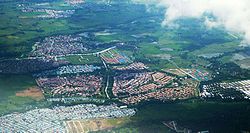Gen. Trias, Cavite
| General Trias City | |||||||
|---|---|---|---|---|---|---|---|
| Component City | |||||||
| Lungsod ng General Trias | |||||||
(From top, left to right) Aerial view of General Trias City showing one of its gated communities, Tejero Bridge, General Trias City Hall, Gen. Mariano Trias Monument, and Cañas River.
|
|||||||
|
|||||||
| Nickname(s): Gen-Tri | |||||||
 Map of Cavite showing the location of Gen. Trias |
|||||||
| Location within the Philippines | |||||||
| Coordinates: 14°23′N 120°53′E / 14.38°N 120.88°ECoordinates: 14°23′N 120°53′E / 14.38°N 120.88°E | |||||||
| Country | Philippines | ||||||
| Region | Calabarzon (Region IV-A) | ||||||
| Province | Cavite | ||||||
| District | 6th District of Cavite | ||||||
| Incorporated (town) | December 13, 1748 | ||||||
| Renamed | 1920 | ||||||
| Cityhood | December 12, 2015 | ||||||
| Barangays | 33 | ||||||
| Government | |||||||
| • Mayor | Antonio Ferrer | ||||||
| • Vice Mayor | Maurito Sison | ||||||
| Area | |||||||
| • Total | 81.46 km2 (31.45 sq mi) | ||||||
| Population (2015 census) | |||||||
| • Total | 314,303 | ||||||
| • Density | 3,900/km2 (10,000/sq mi) | ||||||
| Demonym(s) | Gentriseño | ||||||
| Time zone | PST (UTC+8) | ||||||
| ZIP code | 4107 | ||||||
| IDD : area code | +63 (0)46 | ||||||
| Website | generaltrias |
||||||
General Trias (Filipino: Lungsod ng General Trias), formerly San Francisco de Malabon, is a first-class component city in the province of Cavite, Philippines. According to the 2015 census, it has a population of 314,303 people.
Through Republic Act 10675, a plebiscite was held on December 12, 2015, with majority of its residents voting "yes" to cityhood, thus converting the municipality into a city, in time for its 267th charter anniversary.
During the earlier part of the Spanish colonial period, General Trias was often referred to as Las Estancias (the ranches), which was once a part of Cavite el Viejo, the present-day Kawit. It was also called Malabon Grande. The name Malabon was speculated to have been derived from either the local term "maraming labong," due to the abundance of bamboo shoots in the area, which is a main ingredient in Filipino cuisine; or from "mayabong," referring to the trees and other plants once abundant in the place.
At any rate, the first reference seems to be more probable because General Mariano Trías, a noted writer, adopted the nom de guerre "Labong," a word he often used in his writing and conversation. Grande, on the other hand, was affixed to the appellation because at the time, the place was a vast wilderness covering Sitio Tejero, frequently called by the revolutionary as Salinas (present-day Rosario), Sta. Cruz de Malabon or Malabon el Chico (present-day Tanza) and Tierra Alta (present-day Noveleta). When the town was made independent from Cavite el Viejo, it was finally called by its popular name San Francisco de Malabon, in honor of patron saint, Saint Francis of Assisi (1181-1200).
The first uprising in Cavite known as the "First Cry of Cavite" occurred in San Francisco de Malabon about ten o’clock in the morning of 31 August 1896, when the town tribunal was attacked by Filipino revolutionaries led by Mariano Trías, Diego Mojica and Nicolas Portilla in Pasong Kalabaw (now known as Sta. Clara). The second incident followed at twelve noon at Tierra Alta and the third in Cavite el Viejo between two and three o’clock in the afternoon.
...
Wikipedia







